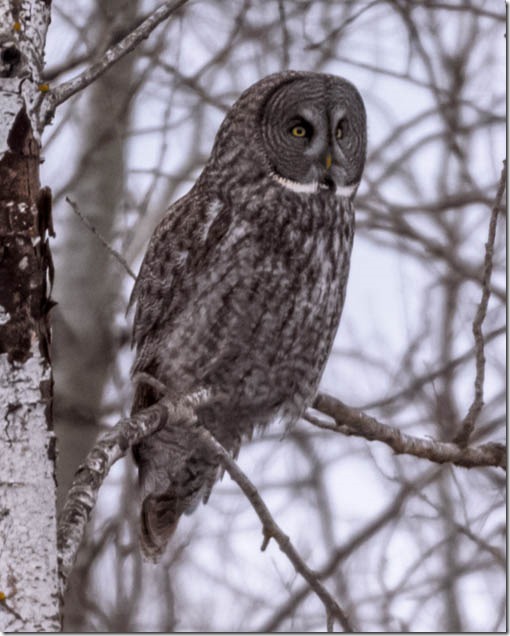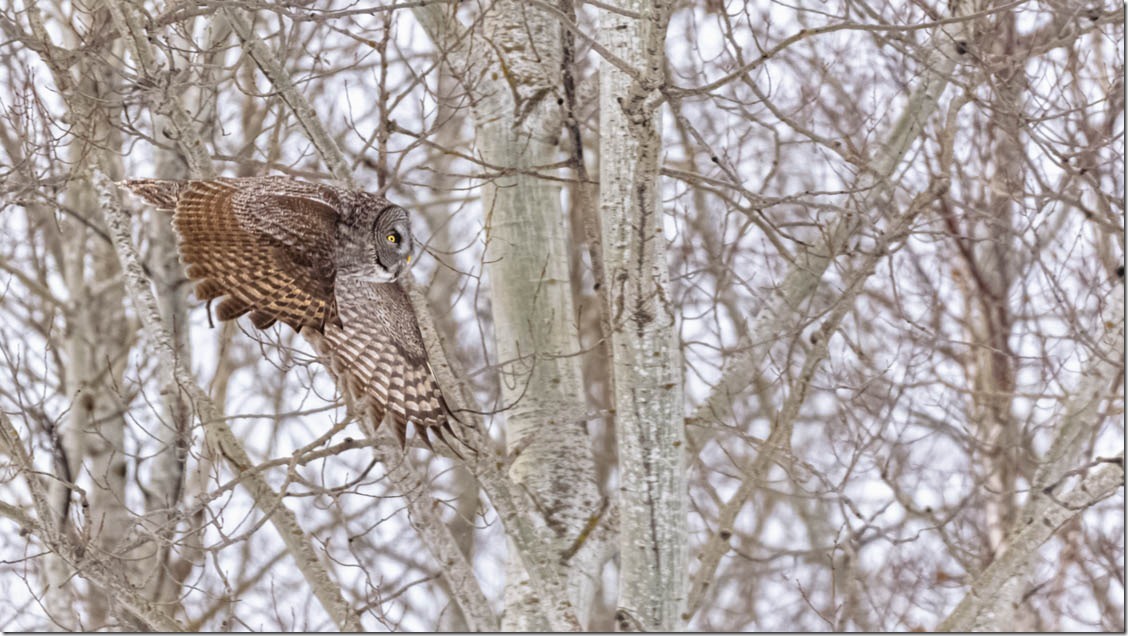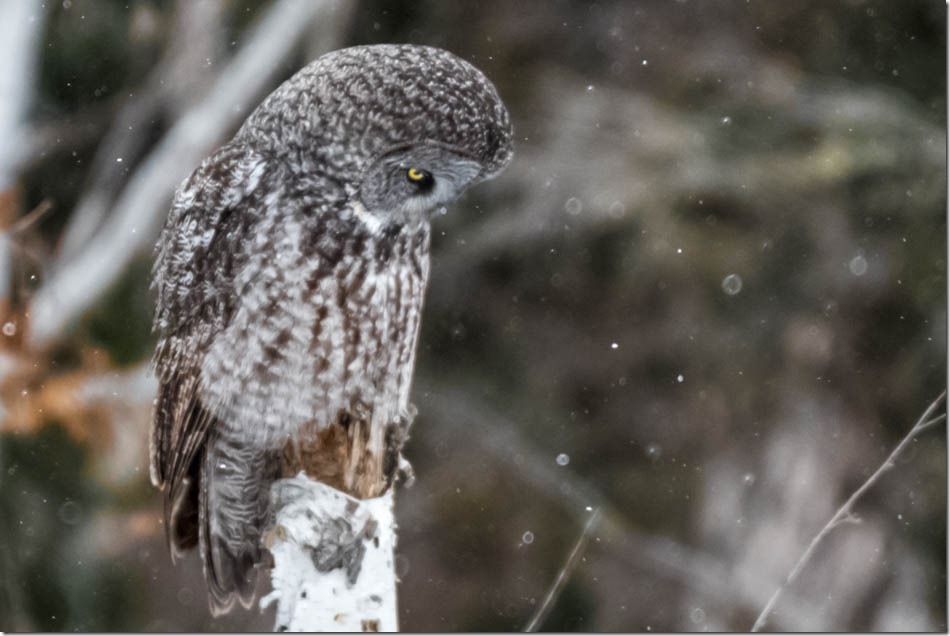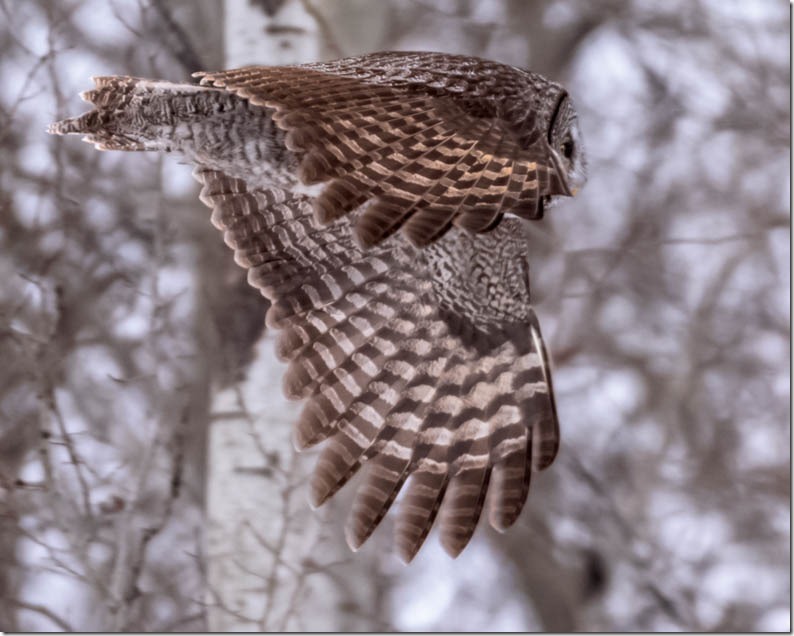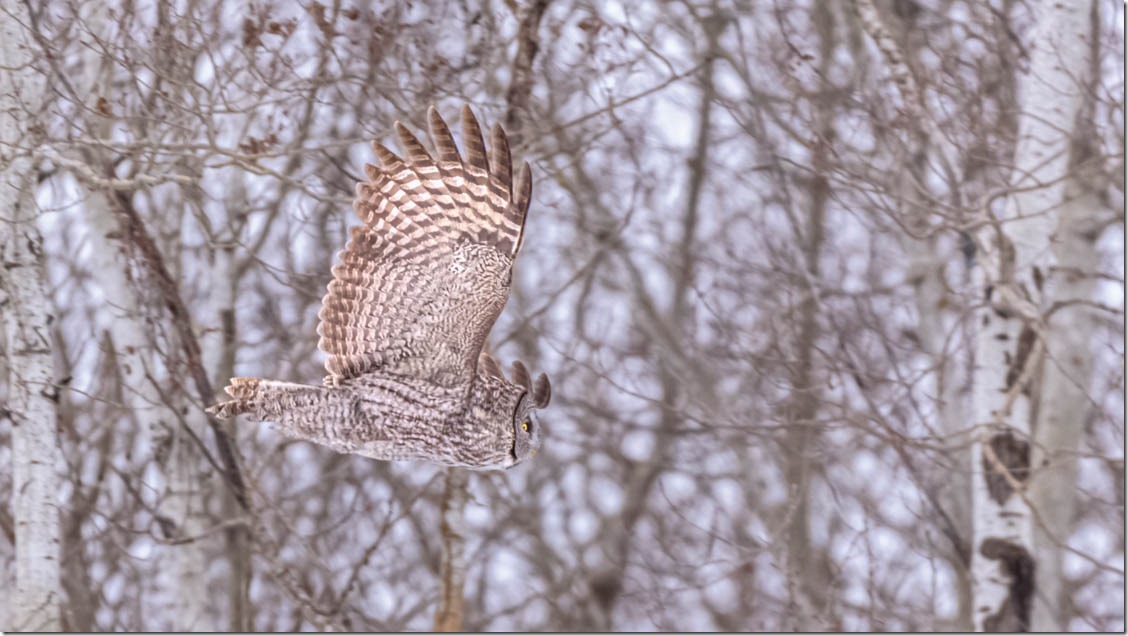What is so special about the Great Gray Owl and how did it become the Province of Manitoba (Canada) Provincial Bird? One of the most sought after birds in North America, ranking 6th among 50 most wanted birds, the Great Gray Owl has been seen in larger numbers in Manitoba than many other places in Canada.
Great Gray Owls listening for voles during a winter snowfall
This large owl has brilliant yellow eyes and a yellow to ivory bill set in a bold facial disk that is finely barred with six or more concentric rings of brown or gray on a white base. It’s relatively long legs are densely feathered, as are it’s feet and toes. The first specimen was described in 1772 and came from Severn, near the Hudson Bay Coast, of what is now Ontario. It has been called the Phantom of the North, the Bearded Owl, and the Sooty Owl.
Great Gray Owl looking for voles
On July 16, 1987 by an Act of the Manitoba Legislature, the Great Gray Owl was officially named the Provincial Bird Emblem. Elevation of the status of the Great Gray Owl from unprotected in 1962 to provincial bird emblem in 1987, is in recognition of owls and other birds of prey as a valuable and treasured part of the natural world, and worthy of protection.** This was all made possible on part through the work of Dr. Robert Nero, who kept an injured nestling that he named Lady Gray’l for education and research. Lady Gray’l became extremely popular wherever she went and moved this species from relative obscurity in a few short years.
Great Gray Owl in silently flies through the thick forest
The Great Gray Owl is the largest owl in North America, having a wingspan of 1.5 metres (5ft), larger in size than both the heavier Great Horned and Snowy Owls, and weighs between 1.2 and 1.4 kg (2.6 – 4 lbs), with the female being larger than the male, as is the case with all birds of prey. It’s main food sources are the Meadow Vole, the Red-backed Vole and the Pocket Gopher, which it silently hunts throughout it’s home in the Boreal Forests of Manitoba.
Great Gray Owls hears something under the snow
The Great Gray Owl can be found from the southeastern tip of Manitoba all the way through the eastern and northern portions of our Province, with rare sightings of this magnificent owl in the southwest part of Manitoba and on very rare occasions has been seen in the City of Winnipeg. In the west it can be found from Riding Mountain National Park north to the edge of the treeline. As with all owls, the Great Gray Owls don’t build their own nests, but rather use nests that were built by larger hawks and ravens.
Great Gray Owl always at the alert for a meal
During extreme winters, the Great Gray Owl may have difficulty finding food in the thick forests, so comes out to the edge of the forest to hunt. It can be found sitting low in a tree, on a fence post or on occasion along a hydro wire or pole, watching and listening patiently for the Voles which are active beneath the snow. When it hears a Vole, which with it’s acute hearing it can hear up to 30.5 metres (100ft) away, it may hover overtop of it, above the snow to get a closer bearing of where it is, and then dive head first, with it’s long powerful legs extended in front of it, through ice crusted snow as deep as 1 1/2 feet that can hold the weight of an adult human.
Plunge marks made from a Great Gray Owl diving into the snow while hunting for voles
An adult owl will make numerous strikes in order to get one meal, and in sub-zero temperatures that can dip to –40 C it expends a lot of energy to survive. Although they prefer to hunt during the half light of dawn and dusk, the Great Gray Owl can be found hunting during full daylight hours, preferring overcast days to full sunlight. During breeding season a family of owls may consume between 15 and 25 voles daily.
Great Gray Owl on the wing
In early spring, the male uses a deep, booming call to attract a mate. A breeding pair usually adopts an unused stick nest of a hawk or raven, but will also nest in the tops of broken trees. The female owl lays her white eggs, usually up to six, at two-day intervals. She sits throughout the incubation, and it falls to the male to fetch food for them both. As a result of the staggered laying process, the chicks hatch over several days. During seasons when food is scarce, the eldest and strongest owlet eats at the expense of younger siblings, which quickly starve.This brood reduction, though seemingly cruel, ensures that at least some young have the best possible start in life. Owlets leave the nest after three weeks, but depend on their parents for a couple of months before dispersing.***
Great Gray Owl in flight moving from one tree to another to hunt for voles
I have yet to find a Great Gray Owl nest with eggs or young in it, and am told that if I do to make sure to keep my distance as the parents will fiercely guard and protect their nests and young, even attacking humans that venture too close. Through many years of trapping, banding and reported sightings, it is believed that there are between 1500 and 3000 Great Gray Owls in Manitoba.
References:
*The Complete Book of North American Owls by Dr. James R. Duncan; Pages 120 - 123
**The Great Gray Owl - http://www.naturenorth.com/Gray_Owl/Gray_Owl.html
***What-When-How - http://what-when-how.com/birds/great-gray-owl-birds/


